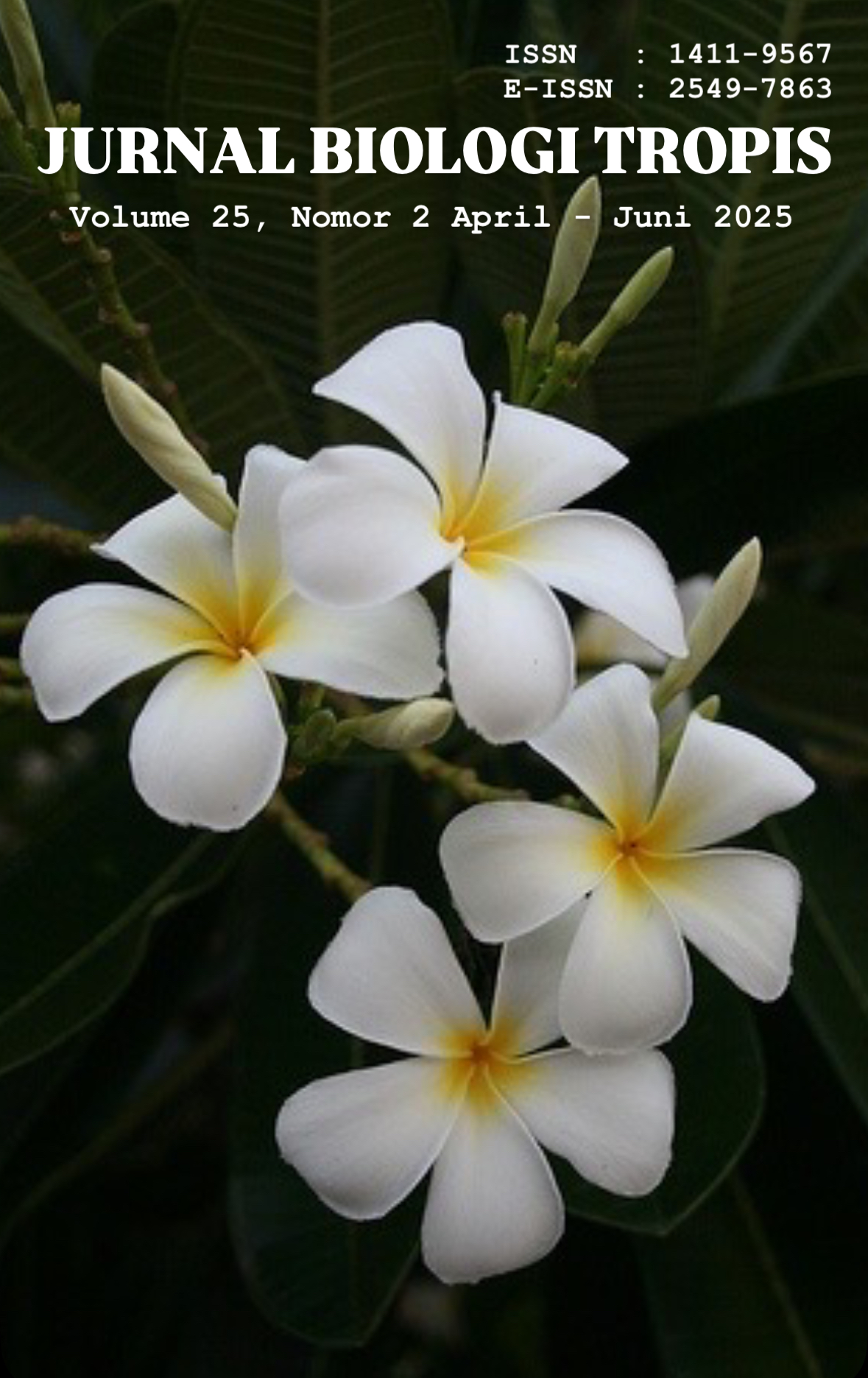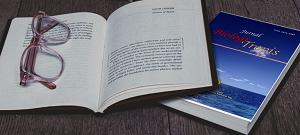Antimicrobial and Antioxidant Activity of Ants Nest Plant Extract (Hydnophytum formicarum Jack.) on The Growth of Test Microbials
Authors
Nurmiati Nurmiati , Periadnadi Periadnadi , Wahyu Dwisa Putra , Vellin Putri SyafrinaDOI:
10.29303/jbt.v25i2.8700Published:
2025-04-22Issue:
Vol. 25 No. 2 (2025): April-JuniKeywords:
Antimicrobial, antioxidant, extraction, Hydnophytum formicarum, polyphenol.Articles
Downloads
How to Cite
Downloads
Metrics
Abstract
Ant nest plants are epiphytic plants that contain active compounds that act as antimicrobials. This study aims to determine the antimicrobial and antioxidant activities of ant nest plant extracts, determine the Minimum Inhibitory Concentration (MIC) and Maximum Killing Concentration (MBC) of test microbes, determine the presence of polyphenols from several ant nest extracts. The method used in this study is the nested pattern experiment method. The results showed that dry brew extract + lime gave a significantly different effect on dry brew extract and dry boil against E. coli and S aureus, but did not give a significantly different effect on C. albicans. The MIC of dry brewed extract + lime against E. coli, S.aureus, and C. albicans is 3.12%, 1.5% and 25%, and is able to kill with an MIC of 6.25%, 3.12% , and 50%. The polyphenol value in the dry brewed extract + lime was 11.28 mgGAE/mL, the dry brewed extract was 9.94 mgGAE/mL, and the dry boiled extract was 4.13 mgGAE/mL. The antioxidant value of dry brewed extract + lime with an IC50 value of 78.14 μg/ml, dry brewed extract with an IC50 value of 98.68 μg/ml in the strong activity category and dry boiled extract with an IC50 value of 106.24 μg/ml in the medium activity category.
References
Amir, M., Ullu, A., & Kusmiati, D. (2020). Uji Aktivitas Antioksidan Tanaman Sarang Semut (Hydnophytum formicarum Jack) dengan Metode ABTS dan Identifikasi Senyawa Aktif Menggunakan LC-MS Antioxidant Activity of “Sarang semut” (Hydnophytum formicarum Jack) with ABTS Method and Identification of Ac. Archives Pharmacia ISSN, 2(1), 43.
Balouiri, M., Sadiki, M., & Ibnsouda, S. K. (2016). Methods for in vitro evaluating antimicrobial activity: A review. Journal of Pharmaceutical Analysis. 71–79.
Cappuccino, J. G., & Sherman, N. (2014). Manual Laboratorium Mikrobiologi Edisi Kedelapan (A. B. N. Miftahurrahman, Ed.). Jakarta: EGC.
Dhurhania, C.E., Novianto, A., (2019). Uji Kandungan Fenolik Total dan Pengaruhnya terhadap Aktivitas Antioksidan dari Berbagai Bentuk Sediaan Sarang Semut (Myrmecodia pendens). J. Farm. DAN ILMU KEFARMASIAN Indones.
Efendi, Y. N., & Hertiani, T. (2013). Potensi Antimikroba Ekstrak Etanol Sarang Semut (Myrmecodia tuberosa Jack.) terhadap Candida albicans, Escherichia coli, and Staphylococcus aureus. Traditional Medicine Journal, 18(1), 53–58.
Ernis, G. (2013). Pengaruh Ekstrak umbi “simbaghutak” (Hydnophytum sp) terhadap Kadar Asam Urat Musmusculus Jantan dan Karakterisasi Hasil Isolasi Menggunakan FTIR.Universitas Bengkulu. Skripsi. Hlm: 17- 19.
Hamidah S, dan Budi S. Kadar Ekstraktif Sarang Semut (Myrmecodia sp) dari Kabupaten Barito Timur. Jurnal Hutan Tropis, 2011 ; 12 (31).
Handayani, F., H. Warnida, S.J. Nur. (2016). Formulasi Dan Uji Aktivitas Antibakteri Streptococcus mutans Dari Sediaan Mouthwash Ekstrak Daun Salam (Syzygium polyanthum (Wight) Walp.). Media Sains. Volume 9: Nomor 1.
Hertiani, T., Ediati, S., Saad, S. & Ulfah, M. (2010). Preliminary Study on Immunomodulatory Effect of Sarang-Semut Tubers Myrmecodia tuberosa and Myrmecodia pendens, OJBS 10(3): 136-141.
Hertiani, T., Ediati, S., Saad, S. & Ulfah, M. (2010), Preliminary Study on Immunomodulatory Effect of Sarang-Semut Tubers Myrmecodia tuberosa and Myrmecodia pendens, OJBS 10(3): 136-141.
Hosoishi S, Park S., Tagane S, Rahman M, Ogata K. (2018). Domatia of the Ant-Plant Hydnophytum formicarum (Rubiaceae) Captured as Nests by Two Widespread Ant Species, Tapinoma melanocephalum and Tetramorium nipponense (Hymenoptera: Formicidae). Entomol News, 127(5):407–12.
Islamoyo, M., Aldi, Y., & Nelis, S. (2017). uji anti inflamasi secara topikal ekstrak etanol umbi sarang semut (Myrmecodia tuberosa Jack) pada mencit putih jantan. Andalas Dental Journal, 5(2), 112–121. https://doi.org/10.25077/adj.v5i2.77.
Jamilah, J. (2015). Evaluasi Keberadaan Gen cat P terhadap Resistensi Kloramfenikol Pada Penderita Demam Tifoid. In Prosiding Seminar Nasional Biologi. 1(1), 146-152.https://doi.org/10.24252/psb.v1i1.2131.
Lingga, A. R., U. Pato & Rossi, E. (2016). Uji antibakteri ekstrak batang kecombrang (Nicolaia speciosa horan) terhadap Staphylococcus aureus dan Escherichia coli. Jurnal Online Mahasiswa Faperta, 3(1), 1-15.
Manoi, F & Ballitro. (2008). Sarang Semut (Myrmecodia) Tanaman Berpotensi Menyembuhkan Berbagai Penyakit. 14(1):26- 30.
Molyneux, P. (2004). The use of the stable free radical diphenylpicrylhydrazyl (DPPH) for estimating antioxidant activity. Songklanakarin Journal of Science and Technology. 26: 211 – 219.
Nurzakiah, N., Desniar, D., & Tarman, K. (2020). Aktivitas Antimikroba Kapang Endofit Dari Tumbuhan Pesisir Sarang Semut (Hydnophytum Formicarum) Hasil Kultivasi. Barakuda 45: Jurnal Ilmu Perikanan Dan Kelautan, 2(1), 35–42.
Pallavi, M., Ramesh, C. K., Krishna, V., Parveen, S., & Nanjunda Swamy, L. (2017). Quantitative Phytochemical Analysis and Antioxidant Activities of Some Citrus Fruits of South India. Asian Journal of Pharmaceutical and Clinical Research, 10(12): 198–205.
Pelezar MJ, Chan ESC. (2008). Dasar- dasar Mikrobiologi 2. Ratna SH dkk, penerjemah: Jakarta: UI Pr. Terjemahan dari: Elements of Microbiology.
Praptiwi, Y. H., Sukmasari, S. & Mulyanti, S. (2009). Daya Antibakteri Ekstrak Daun Sisik Naga Dibandingkan Dengan Ekstrak Daun Saga, Daun Sirih Dan Kayu Manis Terhadap Isolat Bakteri Penderita Periodontitis Kronis. Jurnal Riset Kesehatan, 2(1): 58-64
Prior, R.L., Eu, X., & Schaich, K. (2005). Standardized Methods for The Determination of Antioxidant Capacity and Phenolics in Jurnal B-Dent, Vol 4, No.1, Juni 2017 : 61 – 66.
Ramadhan, G., Hanafi, P., & Sulistiorini, R. (2017). Perbandingan Daya Hambat Flukonazol dengan Mikonazol terhadap Jamur Candida albicans secara In Vitro. In Prosiding Seminar Nasional & Internasional. 1(1), 159- 162.
Ríos, J.L, & Recio, M.C. (2005). Perspective paper, Medicinal plants and antimicrobial activity, Journal of Ethnopharmacology, 100, 80-84.
Soeksmanto, A., Subroto, M.A., Wijaya, H., & Simanjuntak P., (2010). Anticancer Activity,Test for Extracts of Sarang semut Plant (Myrmecodya pendens) to HeLa and MCMB2 Cells, Pakistan Journal of Biological Science 13 (3): 148-151.
Subroto, M.A., & Saputro, H., (2006). Gempur Penyakit dengan Sarang Semut, 11-12, Penebar Swadaya, Jakarta.
Tatukude, P., Loho, L., Lintong, P., (2014). gambaran histopatologi hati mencit swiss yang diberi air rebusan sarang semut (mymercodia pendans) paska induksi dengan carbon tetrachlorida (CCl4). J. E-Biomedik 2. https://doi.org/10.35790/ebm.2.2.2014.4999
Vita, A. D. P., J. Posangi, E. Nangoy dan R. A. Bara. (2016). Uji Daya Hambat Jamur Endofit Rimpang Lengkuas (Alpinia galangal I.) terhadap Pertumbuhan Bakteri Escherichia coli dan Staphylococcus aureus. Jurnal e-Biomedik. 4(2). Volk and Wheeler. 2004. Mikrobiologi Dasar. Jakarta: Erlangga.
License
Copyright (c) 2025 Nurmiati Nurmiati, Periadnadi Periadnadi, Wahyu Dwisa Putra, Vellin Putri Syafrina

This work is licensed under a Creative Commons Attribution 4.0 International License.

Jurnal Biologi Tropis is licensed under a Creative Commons Attribution 4.0 International License.
The copyright of the received article shall be assigned to the author as the owner of the paper. The intended copyright includes the right to publish the article in various forms (including reprints). The journal maintains the publishing rights to the published articles.
Authors are permitted to disseminate published articles by sharing the link/DOI of the article at the journal. Authors are allowed to use their articles for any legal purposes deemed necessary without written permission from the journal with an acknowledgment of initial publication to this journal.


























